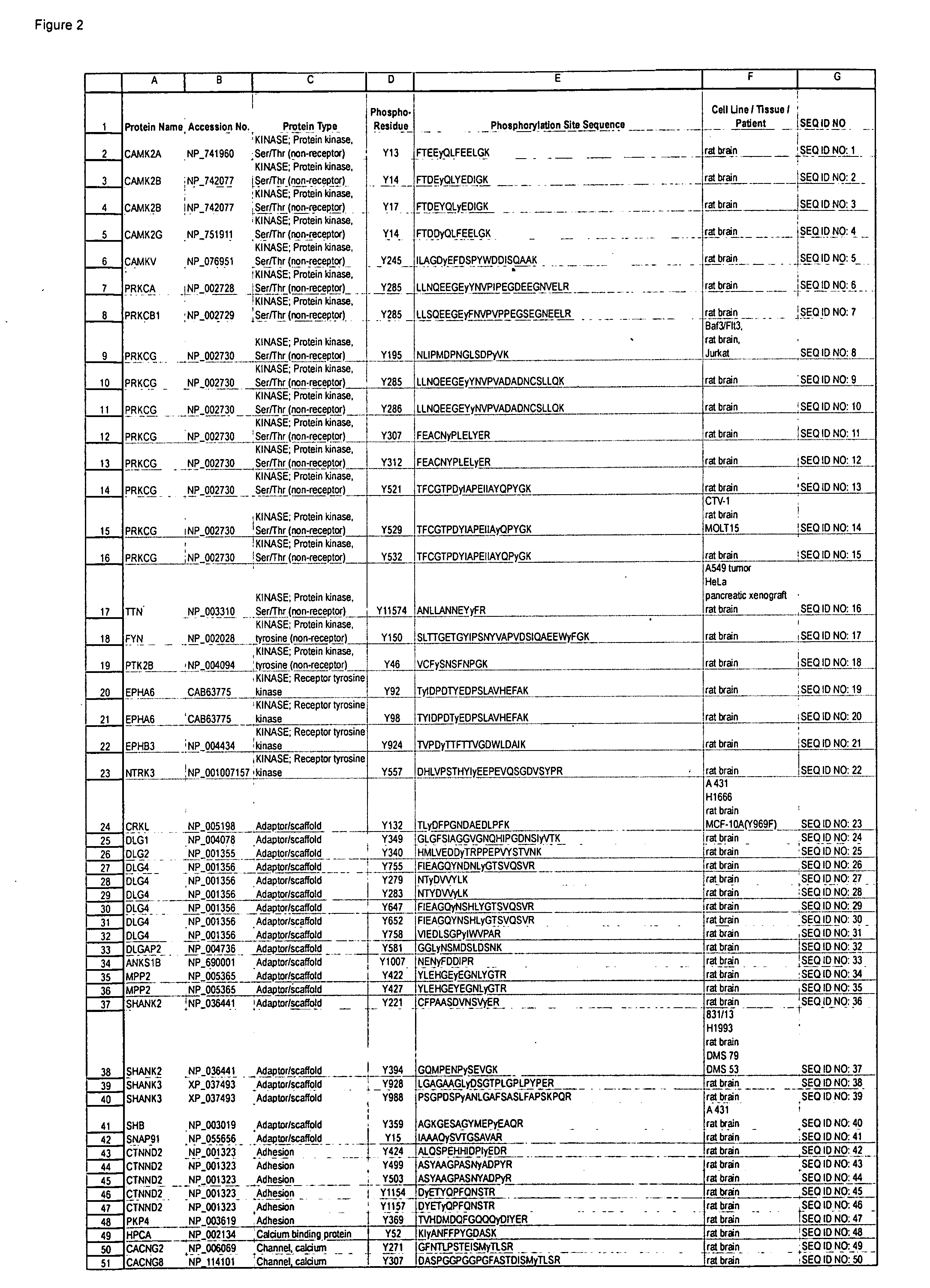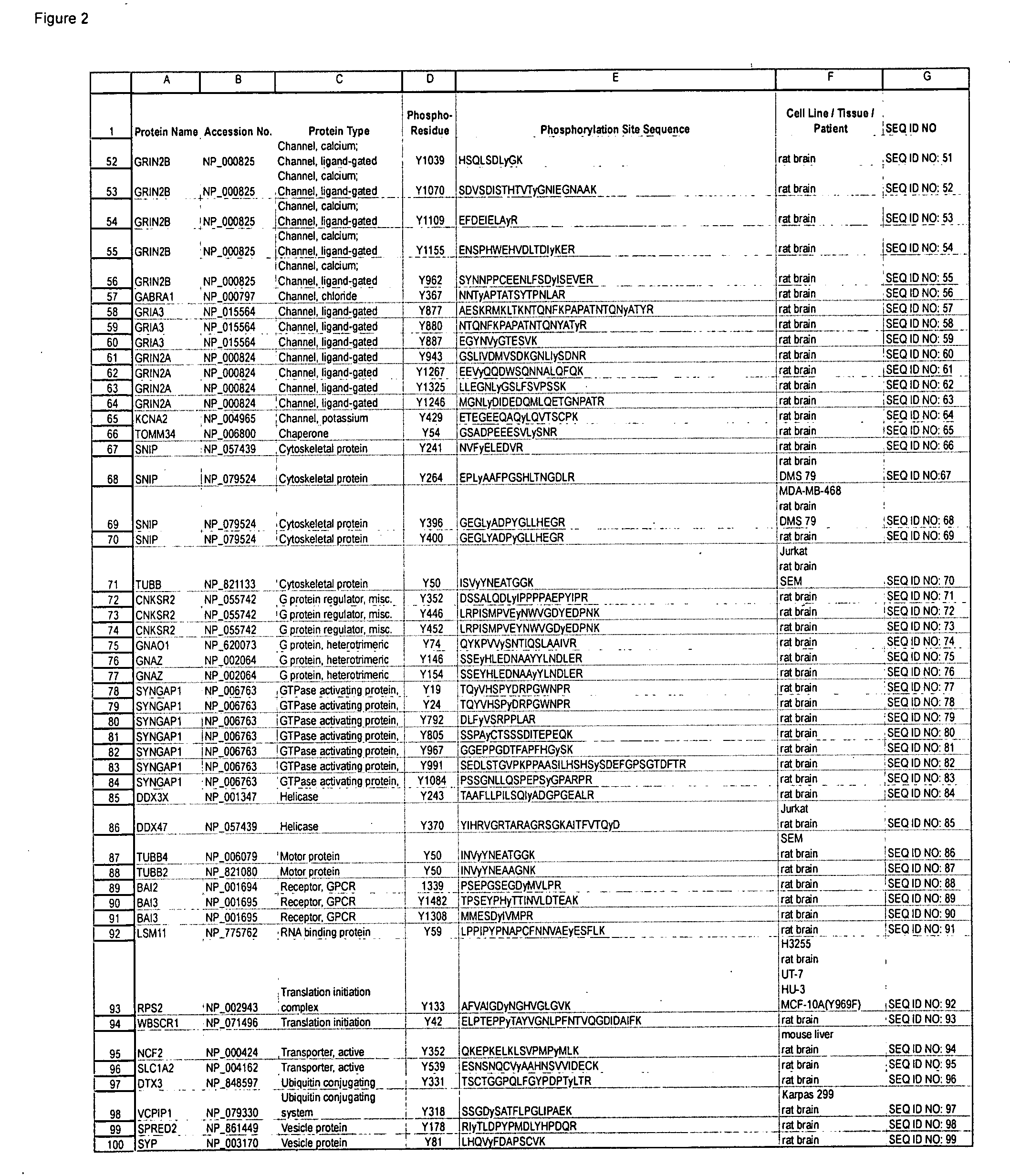Reagents for the detection of tyrosine phosphorylation in brain ischemia signaling pathways
a technology of tyrosine phosphorylation and signaling pathway, which is applied in the field of antibodies and peptide reagents for the detection of protein tyrosine phosphorylation and associated with brain ischemia, can solve the problems of significant tissue damage, unreachable, and unreachable, and achieves the effect of preventing the formation of apoptosis
- Summary
- Abstract
- Description
- Claims
- Application Information
AI Technical Summary
Problems solved by technology
Method used
Image
Examples
example 1
Isolation of Phosphotyrosine-Containing Peptides from Extracts of Brain Ischemia Cell Lines and Identification of Novel Phosphorylation Sites
[0109]In order to discover previously unknown Brain Ischemia-related signal transduction protein phosphorylation sites, IAP isolation techniques were employed to identify phosphotyrosine- and / or phosphoserine-containing peptides in cell extracts from rat brain samples. 10 rats subjected to sham-surgery without ischemia (control), 10 rats subjected to 15 min of ischema and followed by 4 h of repersuion, 10 rats subjected to 20 min of ischema followed by 4 h or reperfusion. Cellular fractions were prepared from these rat brain samples by homogenizing the samples for 50 strokes with a glass-teflon homogeziaer in lysis buffer (TBS, pH7.6, 1 mM sodium orthovanadate, 2.5 mM sodium pyrophosphate). The homogenate was centrifuged at 10,000×g for 20 min at 4 degre to obtain pellet (P2) and supernatant (S2) fractions. P2 pellet was then resuspended with T...
example 2
Production of Phospho-specific Polyclonal Antibodies for the Detection of Brain Ischemia-related Signaling Protein Phosphorylation
[0120]Polyclonal antibodies that specifically bind a Brain Ischemia-related signal transduction protein only when phosphorylated at the respective phosphorylation site disclosed herein (see Table 1 / FIG. 2) are produced according to standard methods by first constructing a synthetic peptide antigen comprising the phosphorylation site sequence and then immunizing an animal to raise antibodies against the antigen, as further described below. Production of exemplary polyclonal antibodies is provided below.
A. CAMK2B (tyrosine 17).
[0121]A 13 amino acid phospho-peptide antigen, FTDEYQLY*EDIGK (where y*=phosphotyrosine) that corresponds to the sequence encompassing the tyrosine 17 phosphorylation site in human CAMK2B Protein kinase (see Row 4 of Table 1; SEQ ID NO: 3), plus cysteine on the C-terminal for coupling, is constructed according to standard synthesis te...
example 3
Production of Phospho-specific Monoclonal Antibodies for the Detection of Brain Ischemia-related Signaling Protein Phosphorylation
[0128]Monoclonal antibodies that specifically bind a Brain Ischemia-related signal transduction protein only when phosphorylated at the respective phosphorylation site disclosed herein (see Table 1 / FIG. 2) are produced according to standard methods by first constructing a synthetic peptide antigen comprising the phosphorylation site sequence and then immunizing an animal to raise antibodies against the antigen, and harvesting spleen cells from such animals to produce fusion hybridomas, as further described below. Production of exemplary monoclonal antibodies is provided below.
A. SHANK2 (Tyrosine 221).
[0129]A 14 amino acid phospho-peptide antigen, CFPAASDVNSVy*ER (where y*=phosphotyrosine) that corresponds to the sequence encompassing the tyrosine 221 phosphorylation site in human SHANK2 Adaptor / scaffold protein (see Row 37 of Table 1 (SEQ ID NO: 36)), plu...
PUM
 Login to view more
Login to view more Abstract
Description
Claims
Application Information
 Login to view more
Login to view more - R&D Engineer
- R&D Manager
- IP Professional
- Industry Leading Data Capabilities
- Powerful AI technology
- Patent DNA Extraction
Browse by: Latest US Patents, China's latest patents, Technical Efficacy Thesaurus, Application Domain, Technology Topic.
© 2024 PatSnap. All rights reserved.Legal|Privacy policy|Modern Slavery Act Transparency Statement|Sitemap



